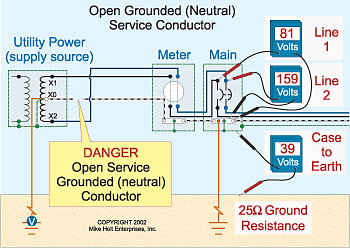https://www.mikeholt.com/mojonewsarchive/NEC-HTML/HTML/DangerofOpenServiceNeutral~20020816.htm
"If the grounded (neutral) service conductor is opened or not provided at all, objectionable neutral current will flow on metal parts of the electrical system and dangerous voltage will be present on the metal parts providing the potential for electric shock"

The utility company told me this is the main reason we omitted the use of neutral and 120v in the Philippines even when USA designed our power system with similar centertap configuration because we don't have the discipline to follow all the codes. And the death from open service neutral can be more than ground fault electrocution. It's not because its illegal to use 120v but more of safety.
So I avoided using 120v too in my parents house (most switching adaptors in most gadgets nowadays and even entertainment units like TV or home theater use universal 100-240v so anyone can use in any part of the world).
Yesterday I realized we have one 120v unit installed that I didn't consider before! In our commercial building, we have full 3-wire so have access to the neutral in the service entrance and main panel. And Equipment Grounding Conductor and stuff is readily available. All my questions before is related to my parents home where there is no 3-wire in the entire townhouse compound with other 5 houses. Many new commercial building are 3 wire but not normal homes.
I bought a Siemens First Surge 140,000A Surge protector a few months back after a 65 year old EE advised me how to use it locally, and installed it in the commercial building.
https://www.amazon.com/Siemens-FS14...F8&qid=1544142905&sr=8-1&keywords=first+surge


The above was the Siemens First Surge installed in a subpanel with bolt-on breakers. It was just temporary setup. The proper way is to install it at the right side so the ground/neutral leads would be as short as possible.
Now here is the problem.
If the service neutral becomes open or disconnected. The electricity will reach all the metal enclosure in the building because the neutral and ground is bonded at the main panel (My connection in the office building is USA style with centertapped grounded neutral connected to the building and bonded with ground once and 120v, 240v available). This is how I power the Siemens First Surge which require 120v to operate and not 240v or it would burst into flame.
Now can you think of ways to integrate GFCI or RCD so that if the neutral got disconnected, the Siemens First Surge would lose power?
I saw someone make an open service neutral detector:
https://www.thaivisa.com/forum/topic/457002-the-hazard-of-an-open-circuit-neutral/

Or without reading them. Just imagine the neutral part of the toroid differential circuit, if the neutral got disconnected.. think of a way it can disconnect the circuit by right connections of them all.

Ok to use isolation transformer in conjunction with the SPD and GFCI/RCD. But I have to make sure the unique connections will work and verifying with many before letting the master qualified electrician install any.
Thank a lot.
"If the grounded (neutral) service conductor is opened or not provided at all, objectionable neutral current will flow on metal parts of the electrical system and dangerous voltage will be present on the metal parts providing the potential for electric shock"

The utility company told me this is the main reason we omitted the use of neutral and 120v in the Philippines even when USA designed our power system with similar centertap configuration because we don't have the discipline to follow all the codes. And the death from open service neutral can be more than ground fault electrocution. It's not because its illegal to use 120v but more of safety.
So I avoided using 120v too in my parents house (most switching adaptors in most gadgets nowadays and even entertainment units like TV or home theater use universal 100-240v so anyone can use in any part of the world).
Yesterday I realized we have one 120v unit installed that I didn't consider before! In our commercial building, we have full 3-wire so have access to the neutral in the service entrance and main panel. And Equipment Grounding Conductor and stuff is readily available. All my questions before is related to my parents home where there is no 3-wire in the entire townhouse compound with other 5 houses. Many new commercial building are 3 wire but not normal homes.
I bought a Siemens First Surge 140,000A Surge protector a few months back after a 65 year old EE advised me how to use it locally, and installed it in the commercial building.
https://www.amazon.com/Siemens-FS14...F8&qid=1544142905&sr=8-1&keywords=first+surge


The above was the Siemens First Surge installed in a subpanel with bolt-on breakers. It was just temporary setup. The proper way is to install it at the right side so the ground/neutral leads would be as short as possible.
Now here is the problem.
If the service neutral becomes open or disconnected. The electricity will reach all the metal enclosure in the building because the neutral and ground is bonded at the main panel (My connection in the office building is USA style with centertapped grounded neutral connected to the building and bonded with ground once and 120v, 240v available). This is how I power the Siemens First Surge which require 120v to operate and not 240v or it would burst into flame.
Now can you think of ways to integrate GFCI or RCD so that if the neutral got disconnected, the Siemens First Surge would lose power?
I saw someone make an open service neutral detector:
https://www.thaivisa.com/forum/topic/457002-the-hazard-of-an-open-circuit-neutral/

Or without reading them. Just imagine the neutral part of the toroid differential circuit, if the neutral got disconnected.. think of a way it can disconnect the circuit by right connections of them all.

Ok to use isolation transformer in conjunction with the SPD and GFCI/RCD. But I have to make sure the unique connections will work and verifying with many before letting the master qualified electrician install any.
Thank a lot.




